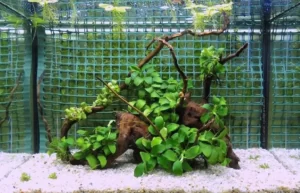
What To Do With a Dead Snail in a Fish Tank?

Writer at The Aquarium Keeper
Aquarium snails are heavily loved and are one of the most popular pets kept in fish tanks. But just like all living creatures, snails also reach their biological capabilities and die. It is a sad moment for every fish keeper, but it is very important to understand and know what to do with a dead snail in an aquarium. Continue reading this article to find out more!
How to Tell if a Snail is Dead?
If your aquarium snail is not moving for some time, you can’t automatically assume that it is dead. There are a few easy ways to check the snail and see if it is alive or not. Here are some reliable methods to check on your snail:
- Smell the snail. Carefully take your snail out of the aquarium and give it a quick smell. If you encounter a disgusting strong smell, it means that your snail is definitely dead, and if not, it is indeed alive and resting. It is the most reliable way of checking on your aquarium snails.
- Check for obvious injuries. Snails are very fragile creatures, and can easily die from injuries. If your snail is not moving for a long time and has injuries (heavily cracked shell, missing parts), there is a good chance that it is dead.
- Try to open their trapdoor. Snails go to their shell as a defense mechanism and don’t come out even if you try to open their trapdoor. Try to carefully pull on the trapdoor, if you manage to easily open it without any snail movement and resistance, there is a good chance that it is dead.
- Put some food next to the snail. This method is not that reliable, but food can trigger your snail to come out of its shell. If the snail still does not move, it still might be alive, so try other mentioned methods.
- Flip your snail over. Snails really do not like to be upside down, since it leaves them vulnerable to predator attacks. If you do not have any aggressive tank mates, this method might help you determine whether the snail is alive or not.
- Move your snail to a new environment. If you have a spare tank, try moving your snail. A new environment and slightly different water parameters might trigger your snail to go out and explore its surroundings. If it does not react, there is a chance that it might be dead.
The most reliable and best way is of course the smelling method, although some people can’t really handle disgusting smells. Because of that, there are other methods, that are slightly less reliable but can help you figure out the status of your aquarium snail.
How to Deal With a Dead Snail?
Moving on, there are really only a couple of options you can choose when dealing with a dead snail in an aquarium. Whichever option you choose depends solely on you and your aquarium’s capabilities.
Move The Snail Out
The most obvious one is to simply take the snail out of the aquarium. Dead aquarium snails have a tendency to decompose quickly, which can lead to a large ammonia spike and a change in water parameters. Other fish and creatures can become negatively affected if you decide to leave a dead snail in your aquarium. It is simply the safest and most obvious way to handle that kind of situation.
If you decide to take your snail out, there are a couple of safety precautions I recommend. Be sure to follow them, since they can help the environment:
- Use gloves or utensils to take the snail out. If you are using bare hands or some sort of utensil, be sure to wash it after scooping the snail out.
- Do not flush it down the toilet. Flushing aquatic creatures is not a good way of disposal. Toilets and pipes are meant for handling human waste and toilet paper, and the shell of a snail can cause blockage.
- Bury the snail in the ground. This is the best way of disposal since the decomposing snail will give back to the environment. Be sure to bury it deep enough, so that wild cats and foxes would not dig it up.
- Dispose of the snail in the trash bin. Put the snail into the ziplock, so the smell and the remains would be isolated.
Leave The Snail
If you know that your snail is dead, you can try to leave it in the tank. This method will only work if the snail is not large (not bigger than ramshorn snails), and if you have a cleanup crew in your tank (other snails, shrimp). A bunch of scavenger creatures can easily devour a deceased small snail, and that can’t really affect your water parameters in any way. Be careful, if you decide to keep the snail in because this method requires a good clean-up crew and a small deceased snail to work.
Only Remove The Corpse
Moving on, if you really like the snail shell, and want to keep it inside your tank, even though the snail is already dead, you can do that by removing the corpse from the shell. Manual removal with hands can sometimes be very messy and is not recommended. What you can do is boil your deceased snail for 5-10 minutes, after that let it cool off. This will make the corpse easily removable from the shell.

Boiling your deceased snail can also kill off all the potential bad parasites that initially might have killed your snail. After removing your snail’s corpse, rinse the shell and leave it somewhere to dry for a couple of days. Be sure to give it a smell before putting it back into the tank for visual purposes. If it smells bad, try to rinse it more with water and leave it to dry for a couple more days.
How Often do Snails Sleep?
Aquatic snails are very interesting creatures when it comes to sleep. It is important to understand the sleeping patterns of an aquatic snail, otherwise, you can easily mistake a sleeping snail for a dead one. Most snails have slightly different sleeping patterns, but almost all of them sleep in the same way. For example, according to a snail sleeping pattern study, a basic pond snail can fall asleep for 2-3 days, and then be active for up to 30 hours!

If you see your snail staying in the same place for a couple of days, and are worried that it might have died, simply use one of the methods mentioned above to check on it. Checking on snails is very common in this hobby since these creatures love to sleep for days in the same place.
Reasons Why Aquarium Snails Die
Moving on, it is also important to know the potential causes of your snail death. There can be a lot of different reasons, ranging from bad tank mates to poor water quality. Snails are sensitive creatures, and can easily succumb to their environment. There are also fish, like pea puffers or betta fish, that can be aggressive toward snails and even injure or kill them.
You might also like to read: Do Kuhli Loaches Eat Snails? What You Need to Know
Injuries
Aquatic snails are relatively clumsy creatures, and can easily be injured. Larger species like mystery or nerite snails tend to fall off of leaves and other decorations. That can lead to cracks in their shell or other injuries. These wounds can later be infected by parasites, which eventually kill the snail.
Bad Water Conditions
As I mentioned before, aquarium snails are not hardy creatures, and improper water parameters would definitely kill a snail faster than a fish. High levels of ammonia, nitrites, and nitrates are toxic to any aquatic creature, which includes snails. Aquarium temperature and pH can also harm your snail if these parameters are not suitable for that particular species. Similar to fish, too cold and too hot water can do harm to a snail.
Another serious parameter, that every snail is sensitive to is copper sulfate. Be sure to check your tap water before using it in aquariums, because in some places it has high levels of sulfate, which can easily kill snails.
Lack of Food
Like every creature, snails also need to eat, and a lack of food can slowly kill any snail. Make sure that your snails get enough proper food, and that they can easily get to it. If you have any other bottom-dwellers in your aquarium, snails will probably compete with them for food, so make sure that everybody gets enough of it to thrive.
How Long do Aquarium Snails Live For?
To continue, knowing the lifespan of your snail pet is also good information since that can help you determine, whether your snail is reaching old age or not. If your snail is older, there is a higher chance that it might pass soon. Combining that with a lack of movement or lack of appetite, you can spot a dying snail sooner. Every species has a different lifespan. Here is how long the most popular types of good aquarium snails live:
- Nerite snail: 2-3 years
- Mystery/Apple snail: 1-2 years
- Japanese trapdoor snail: 2-5 years
- Rabbit snail: 2-3 years
- Assassin snail: 1-2 years
- Black devil snail: 2-4 years
There is also a different category of aquatic snails, that is considered bad. Most of them grow not very large and multiply relatively fast. They infiltrate an aquarium from newly brought plants and are known as pest snails. Here is the lifespan of the most popular pest snails:
- Ramshorn snail: 1-2 years
- Bladder snail: 1-2 years
- Pond snail: 1-2 years
- Malaysian trumpet snail: 1-2 years
Frequently Asked Questions
Do Dead Aquarium Snails Float?
Dead aquarium snails sometimes float, and sometimes don’t. This can be a perfect moment to check up on your snail. If it is dead and has a bad smell, take it out. If it is indeed alive, it can indicate, that your snail is having a hard time staying in one place. Gently help your snail to stick to some decoration or a plant in the tank.
Is my Aquarium Snail Dead or Sleeping?
You can easily check on your snail. If your pet is sticking to a decoration or aquarium glass, it is indeed sleeping. If your snail retracts when picked up and shows any sign of movement, it is alive. Otherwise, if your snail shows no movement when picked up, and smells very bad, it is dead.
Personal Experience And Final Thoughts
To summarise, aquatic snails are one of the hardest creatures to determine whether they are well or sick. That is why they can suddenly appear dead in your aquarium. In my own personal experience, smelling a snail is the easiest way to determine the well-being of a snail, and it is as simple as it gets.

Thank you for reading my blog post. This website was created with the sole intention of providing quality information regarding fishkeeping. I have been in the fishkeeping hobby for 8 years, and through many trials and errors as well as online research I gathered a lot of information, which I want to give back to the community.


Pea Puffer: Adorable Little Hunter, Everything You Need To Know




